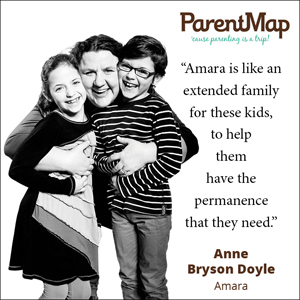
Part I: The situation
When Erika Thompson of Puyallup decided to become a foster parent in 2007, she had well-laid plans. She and husband Brent had two tween daughters and hoped to adopt one boy from foster care to complete their family (more foster kids weren’t part of the picture).
But the route to adoption wasn’t straight-forward, and along the way, she fell in love with fostering. After welcoming six children for short-term stays, she adopted her son Aiden, now 7, in 2011. And she didn’t stop there. She’s now been a foster parent to 114 kids and counting.
As a foster parent educator and recruiter for national foster agency Olive Crest, Thompson tells prospective foster parents to expect surprises. “You can have the best-laid plans, but it almost never works out the way you expect,” she says.
Most newbie foster parents don’t know what to expect, she says, in part because most people don’t know much about what fostering really entails. “You hear the really ugly stories, but not the reality” — a reality that’s thrilling, heartbreaking and unexpected, all at once.
The reality of foster parenting starts with hard numbers. Our state’s foster care system has more children than qualified foster families, and that gap is widening. The state’s foster parent application pool has dwindled since 2012, while the foster child population has edged up since 2010. In 2017, the state reported that 2,577 children entered foster care in 2015, while just 1,350 Washingtonians became licensed foster parents. In total, 10,068 Washington children are in foster care, according to the Adoption Exchange Association, with 2,167 awaiting adoptive families.
For those readers who don’t have a working definition, foster kids are children who, for reasons ranging from the death of one or both parents to abuse and neglect, enter the state’s foster care system. That “system” is a network of agencies and individuals working in partnership with the state to care for vulnerable children, says John Morse, executive director of Seattle-based adoption and foster placement agency Amara.

Compounding the problem of too many kids and not enough homes is the fact that in many cases, a group of siblings seeks placement together. That further narrows the pool of available foster homes, because the state limits the number of children per licensed foster home to six.
“Roughly 70 percent of children in foster care have a sibling, so the request is often ‘Do you have a home for all of these children?’” says Morse. About 60 percent of the time, biological siblings stay together in foster care, well short of the state’s goal of 95 percent.
Because of a shortage of licensed foster homes, foster children in Washington also move more often than those in other states. A state report shows that our state’s foster kids have an average of 5.21 placements in their first year of care (the national standard is 4.12). Rotating through placements slows foster kids’ academic progress to the tune of one year of lost academic progress for every four moves, according to one study.
Foster parent retention is a struggle, too. One study by the U.S. Department of Health and Human Services found that about half of new foster parents quit within their first year. Foster parent licenses must be renewed every three years; those who let their license lapse must completely restart the process (which can take the better part of a year), says Thompson.
This squeeze on care hurts kids; it’s a key driver for the region’s youth homelessness crisis, says Tatyana, a youth network representative for The Mockingbird Society, a Seattle-based foster and homelessness advocacy organization. State data show that each year, 400 teens without a permanent home age out of Washington foster care; one-quarter of them will be homeless within a year.
So why are there more kids and fewer families? Poverty is a factor, says Janis Avery, CEO of Treehouse, a Seattle-based agency providing education resources and support to foster children. “Poverty is a tremendous driver in child abuse and neglect,” she says. In other words, as the region’s economic inequality increases, so does the need for foster homes.
“Another key trend is that more children are entering foster care under 5,” says Avery. “Today, about half are under 5. It used to be around a third.”
Support and advocacy groups to know
- Fostering Together (offers a list of private agencies)
- Northwest Adoption Exchange
- The Mockingbird Society
- Passion to Action
- Treehouse
This is significant because fostering babies and toddlers means higher hurdles for licensed foster parents to jump. Families who foster a baby or toddler must contend with stricter requirements, including rules regarding medical care (for example, newborns must visit a pediatrician shortly after entering foster care), immunizations (all family members must get a flu shot in order to foster babies and toddlers) and child care (finding a licensed day care that accepts infants as well as Department of Social and Health Services [DSHS] payment can be a struggle in the child-care-strapped Puget Sound region).
The result? A massive and mounting challenge of finding enough stable foster homes for the kids who need them, says Avery.
Because foster homes are in short supply, kids who need them often spend hours — or sometimes entire nights — in a DSHS office or hotel while a caseworker searches for a placement, says Morse of Amara.
This problem is big enough that Amara opened an Emergency Sanctuary home — the first of its kind in King County — to house kids waiting for a foster home for up to 72 hours. Nicknamed Grandese’s Place, the shelter joined Hand in Hand’s Safe Place in Everett in providing immediate, temporary housing for kids in crisis; Amara opened another Emergency Sanctuary home in Pierce County in 2016. Since opening in 2014, Grandese’s Place has housed more than 500 children. “We want to give these kids a soft place to land,” Morse says.
Part II: The myths
The state’s foster care system is in crisis. More children are entering the foster care system — a fact that a recent series by Crosscut and InvestigateWest attributes in part to rising rates of opioid drug use and other factors — with a larger share under age 5 (younger children necessitate stricter requirements for foster families, and some foster parents elect not to take children under age 2). The number of available foster homes simply isn’t keeping pace with demand. Foster families of color are particularly needed, as children of color are overrepresented in the foster system (African American children, for example, are more than twice as likely to be in out-of-home care as their white counterparts, according to Partners For Our Children).
One factor in this crisis may be prominent myths that surround foster parenting.
Myth No. 1: Nontraditional families aren’t welcome
There’s a well-known television ad that says “Not everyone can be a foster parent.” But in truth, while foster parenting isn’t right for everyone, all types of families can foster, says Sheri Novak of Tacoma. As licensed foster parents, Novak and her partner, April Stallings, have cared for more than 160 foster children over the course of three decades. Single parents, same-sex partners, working parents, renters and those with biological or stepchildren living at home can become foster parents.
While foster parenting isn’t right for everyone, all types of families can foster.
One requirement that’s fairly ironclad: immunizations. All family members need to be current on shots; flu and pertussis (whooping cough) shots are required for the entire household if foster parents want to take foster children younger than the age of 2.
Myth No. 2: You’ll go broke
Do foster parents foot the bill for all expenses related to raising foster kids? Not exactly.
“It still surprises me that people assume that foster parents have to find extra money in their own budgets to foster,” say Thompson.
The application and licensing process are free, and the state pays licensed foster parents between $500 and $700 per month toward foster kids’ living expenses (more if a child has special needs) and will often reimburse a family’s legal fees if a foster child is adopted. Foster children can also receive pajamas, school supplies and clothing through a number of well-known donation programs, including Mattress Firm’s annual Pajama Bowl.
“Our foster children are comfortable. They have backpacks, they have toys, they have shoes. They don’t go without,” says Novak of her family.
Myth No. 3: Foster kids are problem kids
It’s true that some foster children — understandably, given the challenges they’ve already faced in their young lives — face significant behavioral, academic or emotional challenges, says Avery of Treehouse. “But many are just children born into families with less support than we as a society want to give them.”
Zack, a 19-year-old living in Auburn who spent time in foster care as a teen, recalls being sent to the school office for the minor offense of talking in class and then hearing a high school office worker mutter, “Another foster kid getting in trouble.” He wasn’t sure if he was meant to hear the utterance or not, but the barely concealed disdain were unmistakable.
Today, Zack is a network representative with The Mockingbird Society. He works alongside 21-year-old Tatyana. Tatyana, who was in foster care for most of her teen years, says people often assume foster children must have deep-seated behavioral or emotional problems if they move through a number of placements without finding a permanent home.
“It was frequently assumed that I was bad because I hadn’t found a permanent placement,” she says. The truth: Frequent moves are common since there are fewer permanent homes than there are kids who need them.
Myth No. 4: Goodbye, control — hello, chaos
People often think that fostering means accepting bewildered children in the middle of the night with no time to think it over, says Lisa Bresnahan, an adoptive mom of two foster teens who lives in Sammamish.
Midnight calls can and do happen, but it certainly isn’t the rule, Bresnahan says. “In reality, you can meet with a child a number of times before you make a decision about whether that child fits into your family,” she says. Bresnahan met both of her foster kids at the Northwest Adoption Exchange Kids’ Fest, an annual carnival-type event set in both Seattle and Tacoma where children in foster care and prospective foster and adoptive parents can meet.
Like adoptive parents, foster parents can specify the types of foster children they’ll accept. Some choose to house kids of a specific age or gender, or kids with or without certain developmental disabilities, says Thompson.
Myth No. 5: Foster parenting means heartbreak
It’s true that becoming a foster parent means making peace with impermanence as some 50 percent of foster kids will return to their birth parent(s). That is, after all, the goal: “The safe reunification of families is what we hope for,” says foster parent Stallings, partner of Sheri Novak and director of Comprehensive Life Resources’ Pearl Street Center in Tacoma, a behavioral health support agency serving foster children.
It’s true that becoming a foster parent means making peace with impermanence.
However, that doesn’t mean that foster parents shouldn’t “get attached,” says Monique B. Mitchell, Ph.D., a professor at the University of South Carolina’s College of Social Work and author of The Neglected Transition: Building a Relational Home for Children Entering Foster Care.
Whether children are in a foster home for several days or a decade, “We have to remember that these are relationships. We get caught up in forever, but in reality, nothing is forever,” Mitchell says.
She tells caregivers to address this “temporal ambiguity” — or lack of clarity about the duration of the foster parenting relationship — with honesty.
“We can say [to foster children in our care], ‘I don’t know how long you’re going to be with me, but every day and every moment that you’re in my care, I will care for you, I will support you and I will not let you down.’” Investing in the relationship — even if it’s a short one — offers the children a sense of security, worth and belonging that endures long after they leave your home, Mitchell says.
Myth No. 6: Fostering a teen — are you crazy?
Mention a plan to foster teens, and you’ll get looks of pity, admiration or a mix of both, says Bresnahan of Sammamish, who legally adopted two teens from foster care. The numbers tell the same story. Teenagers are adopted at a lower rate than other children from foster care: More than 20 percent of foster children awaiting adoption are teens, but they represent only 5 percent of children who enter care.
All teens — including those in foster care — need a listening ear, compassionate caregivers, structure and support, and there are resources to help. Treehouse, for example, offers academic support via educational specialists who meet with a teen regularly and help monitor and encourage academic progress. Amara’s new post-adoption program offers classes, mentorship and ongoing support for adoptive families, which may be particularly relevant once kids hit the sometimes turbulent teen years, says Morse.
All teens — including those in foster care — need a listening ear, compassionate caregivers, structure and support, and there are resources to help.
Fostering a teen brings challenges, says Bresnahan. Her 18-year-old, Howard, nearly failed in school, but with support from Treehouse and Job Corps, he earned his diploma and was recently accepted into Eastern Washington University.
The rewards of fostering a teen are unmatched, Bresnahan adds. “Howard has faced ups and downs, but now he says, ‘I love you so much; thank you so much for all that you’ve done. I know I haven’t always appreciated it.’ I can’t think of a greater gift we could have given ourselves and him.”
Part III: The good news
Those closely involved in foster care stress that caring for vulnerable children is a community responsibility — one shared among neighbors, friends and relatives, along with the state and private agencies. The good news: You can contribute to this network of support, even if you can’t foster a child. And not everyone can — or should — become a foster parent. But there are ways to help, even without a bed to spare.
Donate hours, dollars, supplies or services
Agencies like Treehouse, Amara and others rely on volunteers to staff support groups, transitional homes and donation banks. Host your own donation drive, or donate new or gently used children’s clothing, toys and baby gear to Treehouse’s Wearhouse clothing and toy bank in King County or to Erika Thompson’s Wishing Well Foundation in Pierce County. Both offer a space for foster children to “shop” for clothing and toys, free of charge. Many agencies also welcome the donation of services such as professional photography, tutoring and legal aid.
Become a CASA
Volunteer to become a court-appointed special advocate (CASA) for a foster child or children. CASAs help children involved in cases of abuse and neglect by investigating case facts, recommending a course of action to the court and monitoring progress. CASAs must pass a background check and complete 32 hours of training. Learn more here.
Become a foster parent
Think fostering might be a good fit? Start by visiting the state’s DSHS website or contacting a private agency (find a list here). Attend a free orientation or meet with a county liaison (an agency representative who can help prospective foster parents navigate the process) to learn more. If you are a parent of color, Amara is helping families of color learn more about fostering and adopting, starting with a May 6 conversation at Seattle’s Northwest African American Museum.
The process: First steps to fostering
Whether you hope to welcome just one foster child or dozens, the first step is to get licensed as a foster parent through the State of Washington. Prospective foster parents must begin with a free, drop-in orientation course (registration is not required) that takes place once or twice a month in various locations throughout the state. Online courses are offered, but in-person attendance is encouraged.
Next comes 24 hours of pre-service core training, available as a series of in-person courses in four six-hour sessions or eight three-hour sessions. (The Alliance for Child Welfare Excellence offers multiple training locations throughout Washington.) A home study — generally composed of a couple of visits from a caseworker over a couple of months — and a free first aid/bloodborne pathogens course, offered quarterly.
When it comes to actually welcoming a foster child or children, many families elect to go through an agency like Amara, Bethany Christian Services or Community and Family Services Foundation; such an agency helps walk families through the licensing process, screens prospective foster children and families to help make a good match, and provides an additional layer of support and education to complement the information provided by the state. You can go it alone, but regardless, all foster parents must be licensed through the State of Washington. It’s the state that’s ultimately responsible for the placement and welfare of all foster children, says Thompson of Olive Crest.
The distinction between the state and the various agencies can be confusing, but Thompson tells families that it’s like doing taxes: “You can choose to hire an accountant, who can help with the process and some of the legwork, or you can file directly with the IRS yourself, but ultimately you’re accountable to the government.”











